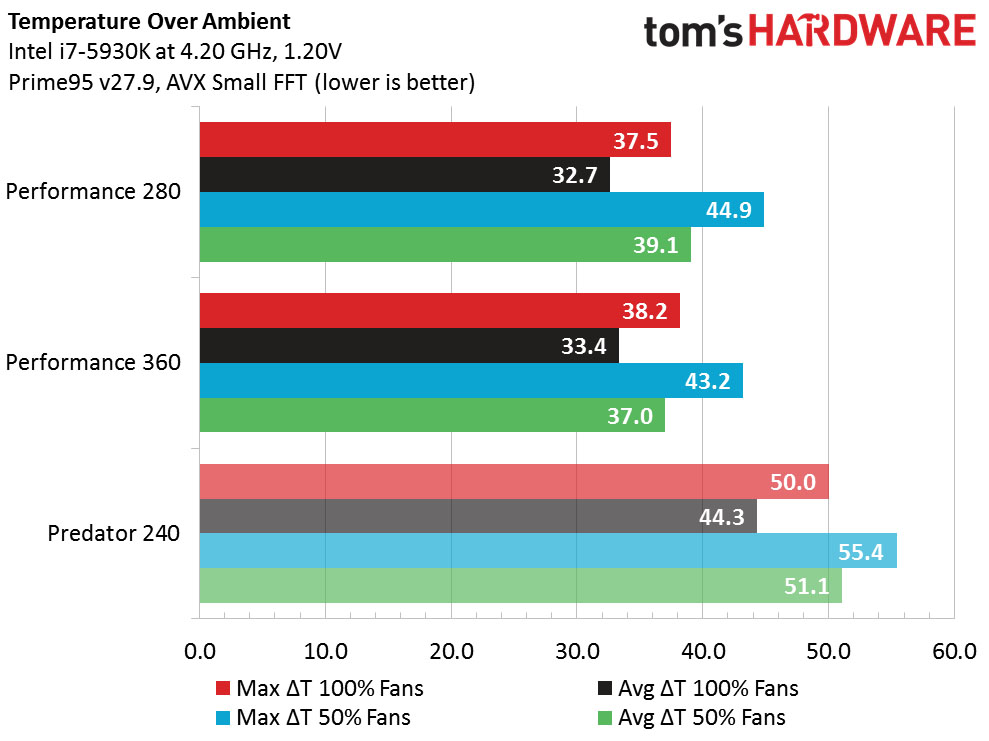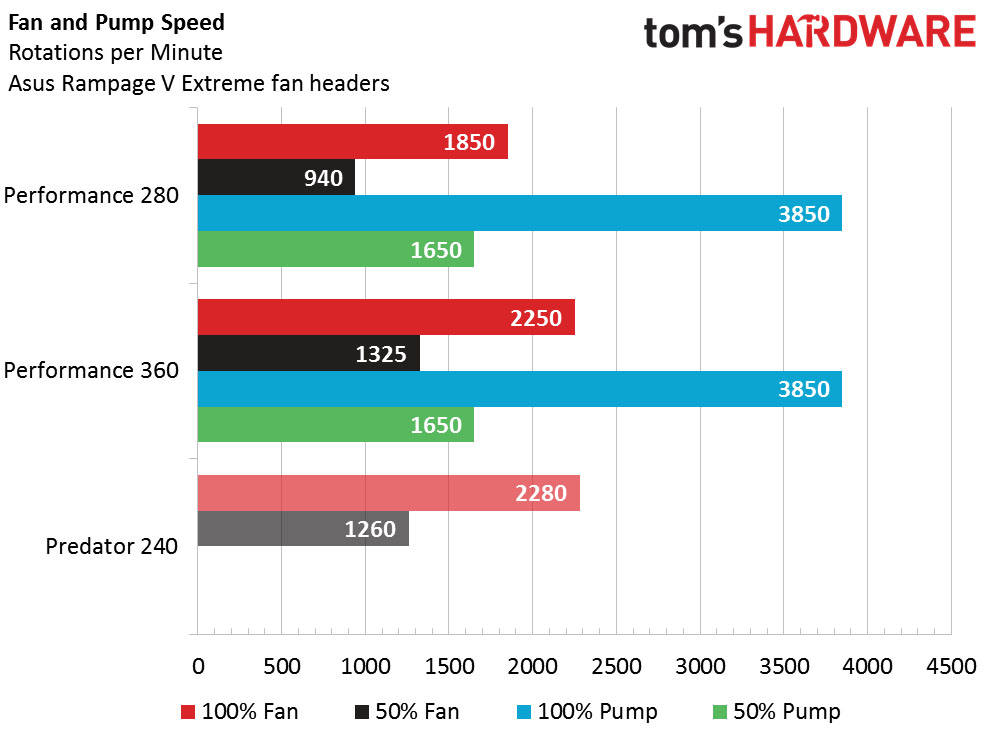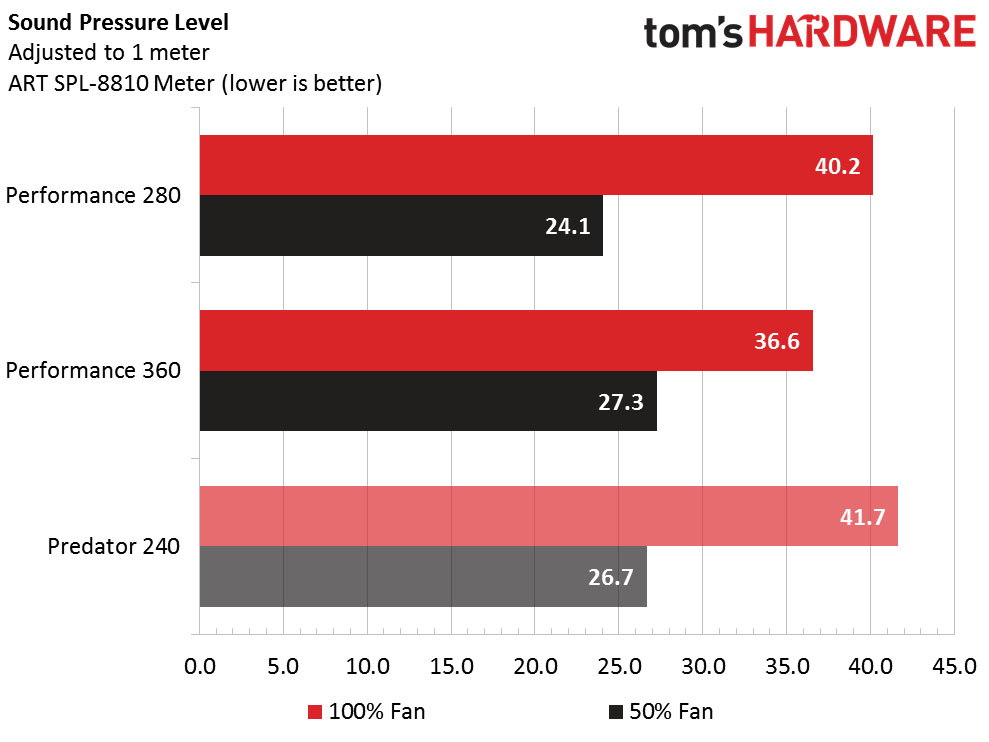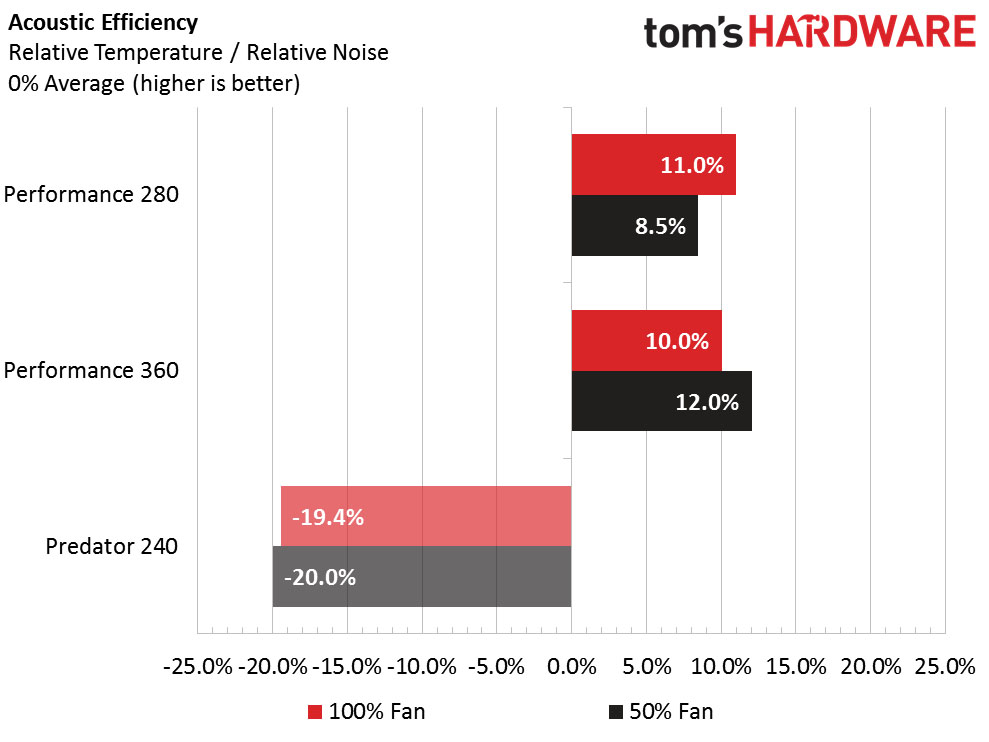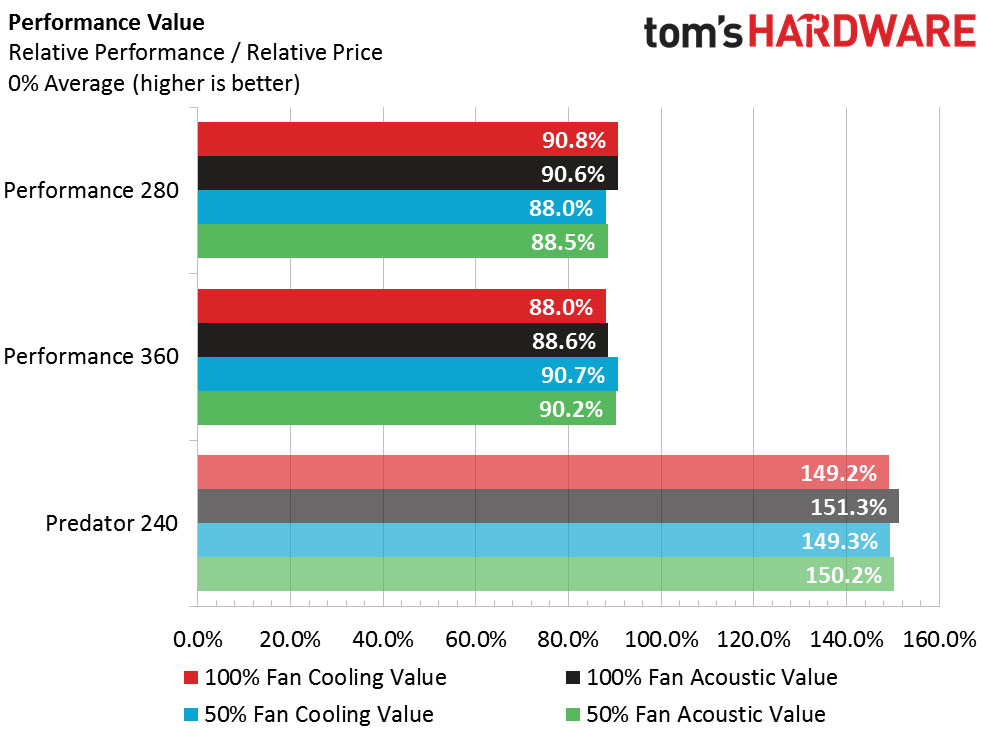EK Performance 280 and 360 Liquid Cooling Kit Review: Open Loops Made Easy
Why you can trust Tom's Hardware
Installation, Test Configuration, Results And Final Analysis
Purchasing a kit may make it easier to gather the necessary parts for a custom loop, but final assembly is still as time consuming as ever. Thoroughly rinsing out the radiator, pump, and waterblock first is critical to make sure all foreign material from manufacture and packaging aren't in the loop. Since this kit was being tested on a Haswell-E CPU, I also opened the waterblock to change it to the recommended configuration (insert I2 and 0.1mm J3 plate). Be careful when handling the jet plates because they are almost thin enough to be razors.
After cleaning the parts, I measured the distance between where the pump, waterblock, and radiator would sit and cut the tubing accordingly. Securing the fittings in the ports, I attached the tubes and fastened compression rings. Next came filling the loop and letting it run a few hours to flush the air from the loop and make sure everything was watertight. My particular setup held about 750mL with the P280, while the P360 held about 680mL.
Altogether the process took about five hours. This isn't a drop-in replacement. If you're going to make the switch to a custom liquid loop, give yourself an afternoon to get everything together. The process is more time consuming than difficult. The instructions are detailed enough for novices to follow provided they pay close attention. The English localization isn't great – EK is a Slovenian company – but it gets the point across (the translation is much better than what I've seen from other products).
Don't forget that open-loop coolers also require more maintenance than sealed AIO and air coolers. In addition to cleaning dust from the radiator grills, the coolant needs to be changed regularly. EK recommends purging and flushing the system and replacing the tubing once a year.
Test Bench Hardware
| Test System Configuration | |
|---|---|
| CPU | Simulated Intel Core i7-5930K (Haswell-E), overclocked to 4.2 GHz @ 1.20V |
| Motherboard | Asus Rampage V Extreme |
| OS | Microsoft Windows 10 Professional x64 (Anniversary Update) |
| Software | Prime95 v27.9 |
In place of the usual i7-5930K Thomas uses is my 5960X. To simulate a 5930K, I found the two hottest cores and disabled them. I then overclocked it in the same way and tested the Predator on it to make sure I was seeing the same temperatures Thomas saw in his review.
The fans were mounted in a push configuration on the radiator. The pump was mounted vertically to my test bench using the universal bracket. The reservoir used the anti-cyclone paddle and foam insert. Noise measurements were taken using the softer pump mount ring. Unless otherwise noted, the pump was set to the same PWM duty cycle as the fans.
Testing Methodology
Each run uses a small FFT pass of Prime95 for at least two hours. Fan and pump speed is controlled by the motherboard's headers. Due to my open test case and the high variability in which a custom liquid cooling loop can be installed, temperature readings for the CPU power regulation heatsink were skipped since they wouldn't be indicative of real world results. Frankly, I simply can't test all the relevant case mounting possibilities for these kits.
Get Tom's Hardware's best news and in-depth reviews, straight to your inbox.
Despite differences in fan size, count, coolant volume, and cooling surface area, the two kits perform very similarly. The P280 takes a small lead at full fans while the P360 is nearly two degrees cooler at half speed. Even at half speed, both perform considerably better than the Predator at full tilt. This isn't terribly surprising considering they have larger radiators and better waterblocks.
Pump Speed Variance
The Predator ties its pump to the same PWM signal as the fans, but open loops can more easily set the pump and fans to different speeds. This is important for optimizing a loop's cooling capacity. Generally, the faster the coolant flows, the better the loop cools. But the pump warms up the coolant due to friction. The more powerful the pump, the more heat it gives off. At faster flow rates it's not impossible for the extra cooling from the higher flow rate to be less than the heat dumped into the loop by the pump.
This was just the P360 kit at varying pump speeds between 25 and 100% PWM duty cycles in 12.5% increments (25, 37.5, 50, 62.5, etc.). There's an almost linear temperature difference between 800 and 1650 RPM. At 2200 RPM, the average temperature drops sharply, though maximum temps aren't changed much. Above 2200 RPM, temperature change is minimal.
It would appear that this pump can run at full tilt without heating the loop too much. However keen-eyed readers will notice the 3850 RPM in the chart is far below the reported 4800 RPM maximum in the pump's specs. Testing the pump on a different board indeed confirms it can go up to 4800 RPM. It seems our test motherboard has some quirky PWM behavior with this pump. However, we see the curve of quickly diminishing returns. Luckily, the top speed ends up right around the pump's sweet spot, so performance isn't negatively impacted.
Fan and Pump Speed
The fans don't seem impacted by the PWM niggles as both are within the +/- 10% expectation. The 140mm fans are right on the low end of it though.
Noise Level and Acoustic Efficiency
We see the fans' rated noise level matches reality. Three fans don't equate to triple the noise of one. Altogether the three 120mm fans are only slightly louder than one. And even though the P360 and Predator share the same fans, we see the Predator is still louder. This may not make sense considering the Predator has one fewer fan, but remember too the P360's pump has its own decoupled mount. The Predator's pump is hard bolted directly to the radiator. Turn the fan and pump down and we see the two fans are quieter than three, as we would expect.
The P280 shows almost the complete opposite behavior. At full speed it's nearly as loud as the Predator, but practically inaudible at half speed. Really, any of these would be near silent at half speed.
There's two ways of beating products at efficiency: do the same work with less effort or do more work with the same effort. The Performance kits can do both compared to the Predator.
Performance Value
EK's Performance kits cost more than twice as much as the Predator and they surely don't cool twice as well or make half the noise. The kits can be expanded, which isn't something you can benchmark, but so too can the Predator. The extra money for the Performance kits nets you a much improved waterblock, more radiator surface area, and a stronger standalone pump, which is significant to overall performance. But these assets are largely wasted on conventional computer systems.
So where do the P280 and P360 kits fit into the scheme of things? By all accounts, these kits are overkill for the vast majority of computer users, even enthusiasts. EK's Liquid line of kits can be had for more than $100 less and would likely be a better value for someone looking for their first step in custom loop cooling. The Liquid line's specs are almost identical to those of the Predator, except that its pump and reservoir are separated.
However, few people take the Mythbusters' "if it's worth doing, it's worth overdoing" mantra to heart like computer tech-heads. Sometimes it seems for every person asking for help building a basic budget computer there are two others piecing together a $2,000 dream machine. It might seem odd having a cooling system that costs more than an entire office PC, but those who really want to push high-end CPUs, particularly Broadwell-E, won't be satisfied with something like a Predator. While this market is actually much smaller than the other, it's the market that EK has founded its business upon. The high-end desktop users who want the performance and pizazz of a custom loop, but don't want to hunt down all the parts, are the ones who will find value in EK's latest offerings.
Final Word
I'm always torn on the final awards for premium products. I don't want to heap too much praise and suggest everyone should sell the farm to buy them. Neither do I want to sell them short as if they're more than anyone needs. Deciding on an award then becomes tricky. Though the P280 and P360 are niche products, and expensive ones at that, the main questions are whether they have any glaring flaws or whether we've seen a competing product perform as well, for a lower price. The answer to both of these is no. The P280 and P360 aren't the best value coolers, nor are they the absolute best available, but you'll be hard-pressed to find a better quality liquid cooling solution for the same money. For that, I give it the Tom's Hardware Editor Approved award.
MORE: Best CPU Cooling
MORE: How To Choose A CPU CoolerMORE: All Cooling Content
MORE: In Pictures: 20 Clever Liquid-Cooled PC Setups
Follow us on Facebook, Google+, RSS, Twitter and YouTube.
- 1
- 2
Current page: Installation, Test Configuration, Results And Final Analysis
Prev Page Introducing EK Performance Kits-
blppt Maybe if you could test a premium closed loop cooler alongside as well, for comparison? Or something like a H115i?Reply -
RedJaron It's already tested against a Predator, which, while expandable, is set up to be a sealed loop also.Reply -
thundervore Reply18772536 said:Maybe if you could test a premium closed loop cooler alongside as well, for comparison? Or something like a H115i?
Testing a custom loop against a AIO is not a good test. The AIO will always loose.
This is because the AIO does not have that much liquid and made with inferior parts (weak pump with built in block, aluminum radiator)
Testing a custom loop with only go head to head with other custom loops like Swifttech, -
blppt Of course the AIO would lose, but for those of us iffy about putting together an open loop, it would have been nice to see by how much.Reply -
1800Allen What would be great is to see the value vs cost vs performance of adding a GPU block in there. It is the next logical step for someone who is getting into water cooling. I know there is GPU addin kits for the Predator line, using the same block and swapping connectors for your custom loop would give some insight on all 3 kits value.Reply -
RedJaron Reply
As I already said, I compared this against a Predator 240. I think more than a few people would consider that a "premium" AIO. You can see how much better the Performance kits were if you looked at the graphs.18774239 said:Of course the AIO would lose, but for those of us iffy about putting together an open loop, it would have been nice to see by how much.
Depends on where you put the value. In straight performance / cost, the more money you put into a custom loop, the more the value drops. You're simply too far past the ideal return on investment point. As I said in the review, you can almost always get better performance value using air. A GPU block is also $100+ on top of the cost for the rest of the loop, which makes it even more cost prohibitive.18774295 said:What would be great is to see the value vs cost vs performance of adding a GPU block in there. It is the next logical step for someone who is getting into water cooling. I know there is GPU addin kits for the Predator line, using the same block and swapping connectors for your custom loop would give some insight on all 3 kits value.
If your value is on noise or consistent temps that allow less thermal throttling, then that's a slightly different matter. However, you're spending $100s to get that small benefit, so again, value in the traditional sense isn't much a factor. -
zodiacfml Didn't notice immediately that this is a different cooler to Anandtech's review.Reply
Am i missing something, that it has 30 degrees above ambient? -
n0ns3ns3 Reply18776518 said:Didn't notice immediately that this is a different cooler to Anandtech's review.
Am i missing something, that it has 30 degrees above ambient?
So ?
let's say the ambient is 25C, so it makes overclocked 6 core 140w (before overclock) CPU to run Prime95 at 55-60C.
That's quite amazing. -
RedJaron Reply
You'll need to specify which Anand review you're referring to as they've covered more than a few liquid coolers.18776518 said:Didn't notice immediately that this is a different cooler to Anandtech's review.
Am i missing something, that it has 30 degrees above ambient?
But yes, Nonsense has explained the temperature delta. The ambient temp during my tests was between 20 - 24 °C ( day to night fluctuation, and yes, I recorded the beginning and ending ambient temp of each test ). The P280 and P360 keep this CPU at least 15° cooler than some of the best big air coolers like the D15 and Dark Rock Pro 3. You just pay more than three times the money for these liquid kits, which is why it only gets an Approved award instead of Recommended.
